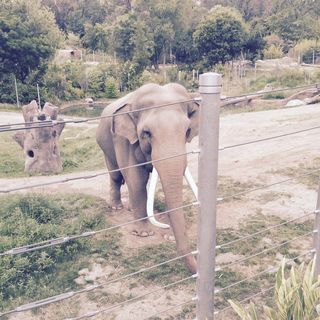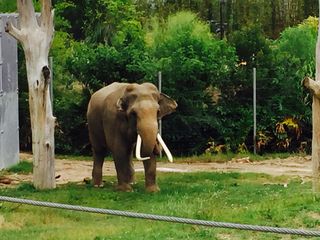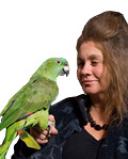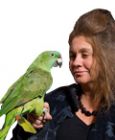Attachment
Behind the Bars, No World
An Interview with Kiersten Cluster on the Elephant, Billy
Posted December 27, 2015

His vision, from the constantly passing bars, has grown so weary that it cannot hold anything else. It seems to him there are a thousand bars and behind the bars, no world.
As he paces in cramped circles, over and over, the movement of his powerful soft strides is like a ritual dance around a center in which a mighty will stands paralyzed.
– Rainer Maria Rilke [1]
This is the second in a series of interviews on Elephant psychology and experience as seen through the eyes of key people working to reinstate Elephant health and dignity. Revered and the source of inspiration for millions over the centuries, Elephants, nonetheless, are killed by the millions for their ivory tusks and made captive for entertainment and lucre. For years, people have been trying to stop the captive trade. Now, with its admission of human-animal brain and mind comparability, neuroscience has transformed the Elephant “welfare” movement into the stark reality of civil rights and social justice.
In a previous interview, Carol Buckley, founder and director of Elephant Aid International and founder and former director of The Elephant Sanctuary in Tennessee, provided a historical perspective on the institution of captivity and its devastating effects on Elephant psyche and society. Here, Kiersten Cluster, J.D., an Early Childhood Special Education teacher for the Los Angeles Unified School District, and lecturer on Early Childhood Special Education, California State University, Northridge, focuses on Billy, a male Asian Elephant in his thirties held in the Los Angeles Zoo. Billy is also the inspiration for The Elephant Letters: The Story of Billy and Kani, a book written for children to see through the eyes of Elephants.
Kiersten, to give readers a little background: About 6 months ago, you started a campaign to transfer Billy from his exhibit at the L.A. Zoo to sanctuary. Can you describe the present conditions in which he lives and his daily routine?
Billy lives alone on approximately one acre of usable space surrounded by metal bars and the constant clicking of electric wires. Heavy gates prevent him from using the entire acre at one time. The lack of living space creates terrible physical and mental stress. As the largest land animal on Earth, Elephants require vast, open spaces. It is one of the most important requirements for the physical and psychological well-being of Elephants.
In the wild, Billy would cover hundreds, thousands of acres, and naturally engage in foraging, dusting, mud wallowing, swimming, resting, and enjoying conversation and developing relationships with other Elephants. Within the constricted zoo exhibit, Billy lives a monotonous and lonely existence without any choices. Elephants exist in the singular only in captivity.
The Elephant brain and mind is collective and social by definition.[2] Billy's life is limited to being moved by zoo staff between enclosures on a human schedule in one of the most urbanized places on the planet. He is forced to walk back and forth across his enclosure to receive treats for the amusement of zoo guests. Most of Billy’s time is spent in a corner, far from the viewing platform, swaying back and forth and bobbing his head.
Finally, the L. A. Zoo staff say that male Elephants live on their own in the wild, which could not be further from the truth. In the wild, Billy would be part of a complex Elephant society where he would form bonds, friendships, with other males, as well as with female family groups.[3] There is no scientific rationale that supports Elephants, male or female, living alone. Above all, Billy would be able to choose where and how far he roamed and when and with whom he would socialize. He would have what we all want for ourselves: agency and the ability to craft a life of his/her own.
Have there been any efforts to improve Billy’s living conditions?
In 2010, the Los Angeles Zoo opened its new Elephants of Asia Exhibit with an increased area for the enclosure and viewing grounds. The area around the exhibit is complete with gardens, sculptures, colorful, shaded pavilions, benches, and nearby concession stands. However, as pretty as it may look and as comfortable as the experience may be for humans, the facts remain that Billy lives deprived and in isolation.
How did your mission for Billy begin?
I have always been an “animal person” and I have always tried to help animals in cases where they have been mistreated, abused or in need—like our pit bulls who live with my family. Furthermore, I have always been opposed to the captive industry. I think it started when I was very young, no more than eight or nine years old. My family and I were visiting a zoo that included a Gorilla exhibit. Until then, I loved being there. It is so wonderful to be close with animals and with family. But that day, I saw through to what animal confinement really is. My parents were off getting some food when I stopped in front of the Gorilla exhibit. There was a huge male Gorilla who looked me right in the eyes. He was so sad, so dignified. He knew who he was and he knew he did not belong there. This stayed with me all my life, but it was not until last year that I became active in wildlife causes.

About a year ago, I started reading about Elephants and I thought that I should see for myself what was happening to Elephants in zoos. So, I went to the L.A. Zoo to observe the Elephants on my own and hear what the zoo education staff were saying and doing. I was shocked. To get a carrot or tomato “treat,” Billy has to walk back and forth from one side of his tiny enclosure to the other (part of the exercise program mandated by the judge that the zoo is appealing). Billy plods along like a robot. The zoo staff stay behind a fence with one person on each side and using treats, they make Billy come to where zoo visitors can see him up close.
In addition, the zoo staff says that his head bobbing behavior is because he is excited to get his treats and that he is very happy. Of course, I saw that this was not true, and as I read later in various science articles, everything I observed in Billy—his head bobbing, swaying, sunken eyes, a depressed, withdrawn demeanor, a palpable feeling of sadness—are typical of Elephants in zoos and circuses. Such stereotypies and dissociation are expression of profound psychological distress and trauma. Billy is kept captive and alone and the public is told untruths that justify zoo policy and actions.
Billy is very special. He has a message to share. I felt that the first time I saw him. There are two other Elephants in the LA Zoo exhibit—Jewel and Tina. They are also in desperate need for release to sanctuary so my emphasis on Billy in no way diminishes the other two Elephants nor their cause. But, there are some individuals with whom you feel an instant connection and Billy is that individual for me. I cannot say that he feels the same. That really doesn’t matter. What matters is that I do everything in my power to help restore his rightful peace, privacy and dignity that have been stolen from him through capture and exploitation. Captivity is not appropriate for any animal. Billy is a symbol for all animals in captivity.
Captive institutions like zoos and aquaria garner significant revenue—they make a lot of money. They justify their existence with the claim that they provide a positive learning experience for families. How does witnessing animal captivity affect you psychologically?
Seeing an animal in captivity suffering like Billy is unhealthy. There is no positive mental or emotional benefit to human or animal. Animal captivity is unnatural and has always bothered me. As I have learned more about wild Elephant society, the fact that Billy was taken from his family at a very young age, and very possibly watched as his family was killed, and has since lived in isolation for human entertainment and profit, is just heart breaking. As a mother myself, I cannot begin to imagine both his pain, and his mother’s pain as her baby boy was torn from her.
Almost every Elephant in captivity has witnessed his or her mother and family killed and been torn away as an infant to live out the rest of his or her life imprisoned. Billy reaches me on a very deep and personal level, and I am driven to speak out for him, and for his mother. When I saw what people had done to him, I just sat down on a nearby bench and cried.
Given your experience with young children—as a mother and a teacher- how do you feel about children learning about Elephants and other animals who are under such stress and traumatized?
I find it horrifying that this is what children are learning. I do not believe that children can learn anything useful about wild animals when they are viewed in a captive situation. Although seeing animals in a zoo may delight children and provide a setting for family time, it is basing something that is wonderful on something that is a horror. It teaches children to be indifferent to the suffering of others, that it is “okay” morally to benefit at the cost of someone's terror, loss, and destruction.
We have a moral and ethical duty to care for our planet and all life, not waste it for our own selfish reasons. Families can find other ways to spend time together that does not cause animal suffering. Children have a natural interest in and affinity for animals. However, they learn from the adult models around them. If the adults in their life display apathetic, uncaring attitudes towards animals, or even outright violence, that is what our children will learn. On the other hand, if we are able to shift our thinking and model respect for all living things, children will follow our example.

What have you learned as an attorney and teacher that pertains to Billy and other wildlife in captivity?
An interesting parallel between Elephant society and our own is the concept of early attachment relationships.[4] In my field of early childhood special education, the family unit is included in the services provided for the child. The child does not exist separately from the family. And the early attachment that a child has with the primary caregiver is crucial to all aspects of development, including the physical development of the brain.
One of the major findings of the Bucharest Early Intervention Project, conducted from 2000-2012, was that early institutionalization of a human child (before the age of two) disrupts the attachment process and leads to serious developmental problems including profound deficits in cognition, reduced brain activity, and a higher incidence of psychiatric disorders such as severe Reactive Attachment Disorder and PTSD. This is exactly the same result for Elephants and other animals taken from their family group at a young age and forced to live in a captive environment.[1] The more I learn about human development and animal society, the more I see that we are more similar than different.
How has your expanded understanding of Elephant psychology—seeing and knowing that other Elephants share so much with us—affected other aspects of your life?
Due to my interest in Billy, I have become more immersed in the animal protection community. As soon as I had seen Billy, I looked for something I could do to help get him released. I learned that there had been a huge movement a few years back to free Billy, but it did not succeed.[5] That did not stop me. I began an online petition and actively seek to raise people’s awareness of Billy’s situation. I believe that most people would not support animal captivity if they knew what was really going on. In fact, while participating in a protest of the use of live animals in circuses, I found that simply educating people about the truth could change their minds and their choices.
There are more changes I have now made. I have been a vegetarian for most of my life. I am now a vegan and an active member of PETA. I have increased my awareness of many issues regarding animal protection, especially in the areas of wildlife conservation and factory farming. Releasing Billy has become one of my top priorities. I have reduced my work load in order to spend more time on this project.
Does the field of trans-species psychology, the fact that neuroscience has established that all animals and humans share common brain structures and process that govern thinking, emotions, and consciousness, make sense to you? Does this provide any new insights into your work?
Yes, the field of trans-species psychology supports what I have always innately known about animals: they have a complex emotional life and form lasting social bonds just like humans. We are more similar to animals than we are different. I find the parallels between humans and elephants with respect to captivity fascinating. And I have personally witnessed the effects of captivity and isolation on Billy when he stands in the corner of his enclosure and sways back and forth and bobs his head. The insight into my work with humans is that we need to educate children about the truth with respect to animals in captivity and their need to live with their families just like us.
As one of the few older Elephant males in North American zoos, Billy is used in Elephant breeding programs where, as in other institutions, he and other males are masturbated by zoo staff to obtain sperm to artificially inseminate female Elephants.[6] Given that psychological comparability across species, how do such programs strike you?
I find the concept degrading for both the humans and the animals involved. I know the zoo is actively looking for a breeding partner for Billy. The two female Elephants at the L.A. Zoo, Tina and Jewel, are considered too old to breed. But to be honest, I did not know how the act of conception was accomplished. And to compound the horror of the process, the result will be more unhealthy Elephants to house in limited space behind bars.

Forced mating of animals does not help animals in the wild, and instead, increases zoo profits by luring the public to see baby animals. A better use of our resources would be finding ways to protect wild populations of animals in their natural environments where they can live and raise families in a natural, dignified manner. Both males and females are highly infertile in zoos (along with high mortality and infanticide, the latter unheard of in the wild), which is not surprising given the terrible stress and devastating conditions they must endure.[7][8]
What would you like tell psychologists?
The same type of paradigm shift that took place in our country with respect to people with disabilities needs to take place with respect to animals. Psychologists' understanding of human minds and those of other animals can be applied to make the change for everyone’s benefit. This is the point of being a professional—taking our knowledge and using it for the good of all. To learn more, please visit the Change.org petition site devoted to his cause.
Literature Cited
[1] Maria Rilke, R. The Panther.
[2] Bradshaw, G.A. 2009. Elephants on the edge: What animal each us about humanity. Yale University Press.
[3] Chiyo, Patrick I., Elizabeth A. Archie, Julie A. Hollister-Smith, Phyllis C. Lee, Joyce H. Poole, Cynthia J. Moss, and Susan C. Alberts. 2011. Association patterns of African elephants in all-male groups: the role of age and genetic relatedness. Animal Behaviour 81, 1093-1099.
[4] Bradshaw, G.A. and A.N. Schore. 2007. How elephants are opening doors: developmental neuroethology, attachment, and social context. Ethology, 113: 426–436.
[5] Los Angeles, 2014. The 12,900 pound Virgin. Los Angeles Magazine. November 25, 2014.
[6] Sperm Collection from a Bull Elephant. YouTube.
[7] Infanticide has become increasingly common in reserves in South Africa where the infant elephants who were orphaned when their mothers and families were killed grow up having endured serial traumas.
[8] Clubb, Ros, Marcus Rowcliffe, Phyllis Lee, Khyne U. Mar, Cynthia Moss, and Georgia J. Mason. 2008. Compromised survivorship in zoo elephants. Science 322, no. 5908: 1649-1649.




